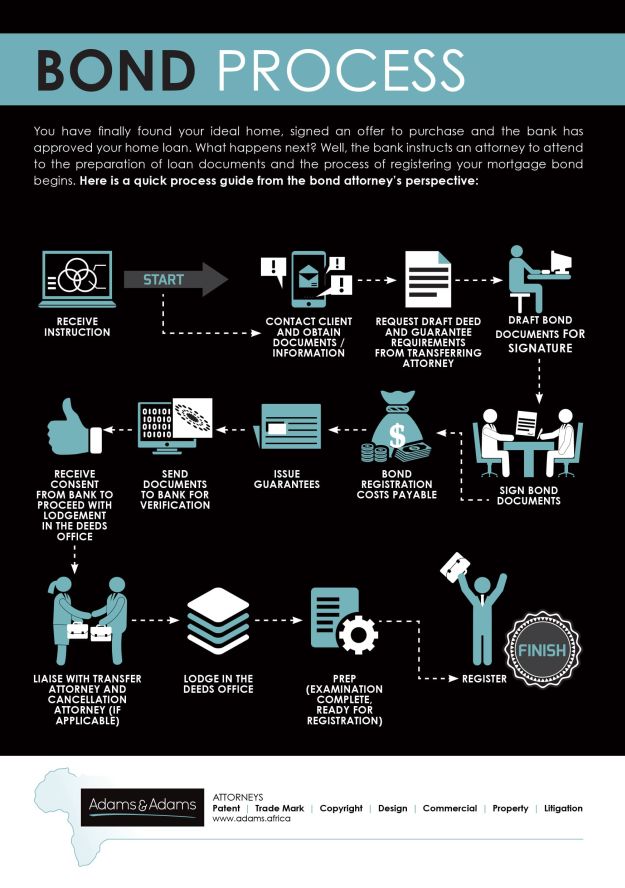- within Finance and Banking, Energy and Natural Resources and Insolvency/Bankruptcy/Re-Structuring topic(s)
- with readers working within the Insurance industries
A mortgage bond is registered when an owner of immovable property uses the property as security to raise funds from a bank or other financial institution. This is either done when purchasing a property or when a property already registered in the owner's name is used to raise funds. The purchaser will apply for a loan from a bank. Below is a guideline of the processes to be followed in order to complete a successful bond registration, specifically when purchasing a property.

1. Attorney receives bond instruction from the bank
Once the purchaser's loan application has been approved, a bond registration attorney will be appointed by the bank to register a mortgage bond over the property as security for the bank.
2. Request draft deed and guarantee requirements from transferring attorney
The bond attorney will liaise with the transfer attorney to provide guarantees for the purchase price or part thereof. The documents for the transfer of the property and the documents for the registration of the bond, should be registered simultaneously at the Deeds Office.
3. Draft bond documents for signature
The bond attorney will prepare the bond documents to be signed by the purchaser. The purchaser will sign the loan agreement, the general terms and conditions to the loan agreement and various affidavits confirming their personal particulars. They purchaser will also sign an Authority to Pay which authorises the bank to pay the proceeds of the bond towards the purchase price of the property being purchased. In addition, the purchaser will sign a Power of Attorney to pass bond and the mortgage bond document. A Power of Attorney to pass bond and the mortgage bond are important documents that will be lodged in the deeds office authorising a conveyancer to appear before the Registrar of Deeds and register the bond on behalf of the purchaser.
4. Obtain insurance certificates
The bank requires the purchaser to insure the structure of the building that is being bonded. The purchaser will be responsible to provide the bank with an insurance policy to the value of the bank's replacement amount. The purchaser may take this insurance with the bank in which event the monthly insurance premium will be added to the purchaser's debit order amount. The purchaser also has the option to provide outside insurance (insurance from an insurance company other than through the bank) in respect of covering the insurance over the building. If the property is a sectional title unit, the body corporate will insure all the units in the sectional title scheme and the premium for this insurance will be recovered as part of the levies that the purchaser will pay on a monthly basis.
5. Bond registration costs payable
The purchaser is responsible for payment of the bond registration costs to the bond registration attorney and the transfer costs to the transferring attorney.
6. Issue guarantees
Once the bond documents have been signed by the purchaser, the bond registration attorneys will issue guarantees to the transfer attorneys which secures payment of the purchase price (or part thereof) of the property.
7. Send documents to bank for verification and receive consent to proceed with lodgement
Once all the bond documents are signed and the bank's requirements, such as the insurance policy for the building, are obtained, the signed documents are submitted to the bank for verification. The bank will then issue its consent to proceed with lodgement of the mortgage bond at the Deeds Office.
8. Lodge in Deeds Office
Once all the documents are in order, the bond documents will be submitted to the Deeds Office for registration. If there are various attorneys attending to different aspects of the transaction their documents will to be linked and lodged simultaneously with the bond registration attorney's documents i.e. the consent to cancel the seller's existing mortgage bond over the property, and the transfer documents by the transfer attorneys.
9. Registration
The process of examination in the Deeds Office normally takes between 8-10 working days from date of lodgement, whereafter the documents come on prep or preparation, which means that the examination process has been completed and that registration can be proceeded with. Once registration is complete a new title deed will be issued confirming that the purchaser is the registered owner of the property. This title deed will be endorsed (a stamp containing certain details) with the fact that a bond is registered against the property. The registered title deed and mortgage bond are released from the deeds office which are then sent to the bank to be kept as security for bank's loan to the purchaser.
The content of this article is intended to provide a general guide to the subject matter. Specialist advice should be sought about your specific circumstances.


